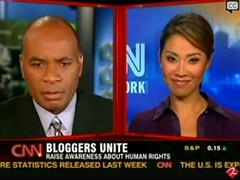Every time I teach social media, I always reference a cartoon once used in a PowerPoint presentation by Gary Gerdemann, director of account services for Peritus Public Relations. The cartoon features two dogs on the Internet with a hilarious caption.
“On the Internet, nobody knows you’re a dog.”
I felt a little like that yesterday, shortly after Veronica De La Cruz, Internet correspondent for CNN's flagship morning news program, American Morning, emailed me, asking which was the best number to reach me. As fate would have it, I was scheduled for a teleconference/online presentation with a major bankcard merchant services client and had to ask for an hour.
De La Cruz didn’t have an hour, but was still very interested in doing a segment on Bloggers Unite For Human Rights. So we did the next best thing. We emailed each other while I was on the teleconference.
I answered all of her questions and provided the most relevant links, like the Bloggers Unite page and Facebook event, where many bloggers are listing their entries for the campaign. And then she asked for a few bloggers who I knew were participating.
Well, you know how it goes. I’ve been tracking all the bloggers who said they would post today, but you never really know until they do. I needed something concrete, like a commitment. So I quickly posted a request on Twitter and BlogCatalog.
“On the Internet, nobody knows you’re a dog.”
Since most who follow me on Twitter do know me, none thought twice. On BlogCatalog, which has approximately 150,000 members, that is not always the case. So while those who know me knew I wasn’t joking, a few members took me to task, saying my request was a “self-gratuitous” hoax. Eesh!
And that is the way it was for about an hour. De La Cruz on email, a major client on a telephone conference call, the online presentation on one browser, and a social network drama on the other browser, where I was being called a liar.
Thanks goodness I know enough bloggers! I sorted a list of twenty bloggers who were committed to posting or had already posted on the subject. I was able to source six mini-biographies and put them at the top. It wasn’t the best-written link list I’ve ever put together, but the job got done.
I started early this morning to finish my own post and then checked the discussion thread…
“It is now 9:56 am est. Did anybody see any of their blogs on CNN …” asked one doubting blogger.
As most journalists and public relations professionals know, there are no guarantees with the news. It’s easy to be bumped by anything "breaking" and several stories were bumped today. For awhile, I thought the Bloggers Unite segment might be bumped too as we were scanned the DVR for the segment.
Thank goodness for an email “ding.” I had missed another e-mail from De La Cruz. While it rarely happens, she had sent me a heads up on the airtime. That was enough for some bloggers, like Kevin, who pens Pointless Banter to find the clip.
His post, Never Again, was one of two blogs featured as an example. He wrote about the atrocities in Durfar. The other, was William McCamment’s Dead Rooster, which touched on the human rights issues in Myanmar. Both have subsequently posted the clip.
“On the Internet, nobody knows you’re a dog.”
Huh. While the cartoon is still funny, there is another lesson to be learned about social media. Sometimes, on the Internet, nobody knows you’re NOT a dog, which is why I always teach that the source, not the medium, is what has credibility.
Special thanks to Veronica De La Cruz, CNN, BlogCatalog, Amnesty International USA, and all those bloggers who worked so hard to put their posts up early this morning. I really appreciate it.
So what’s next for Bloggers Unite? In the next few weeks, BlogCatalog and Copywrite, Ink., in cooperation with Amnesty International USA, will be selecting some posts for recognition. After these posts are announced, I will be profiling three of them right here on Copywrite, Ink.
It’s become an important part of Bloggers Unite not just because one good deed deserves another, but because it places weight behind the effort, ensuring that Bloggers Unite For Human Rights is not just a flash in the pan. It's something we could all think about more often.

“On the Internet, nobody knows you’re a dog.”
I felt a little like that yesterday, shortly after Veronica De La Cruz, Internet correspondent for CNN's flagship morning news program, American Morning, emailed me, asking which was the best number to reach me. As fate would have it, I was scheduled for a teleconference/online presentation with a major bankcard merchant services client and had to ask for an hour.
De La Cruz didn’t have an hour, but was still very interested in doing a segment on Bloggers Unite For Human Rights. So we did the next best thing. We emailed each other while I was on the teleconference.
I answered all of her questions and provided the most relevant links, like the Bloggers Unite page and Facebook event, where many bloggers are listing their entries for the campaign. And then she asked for a few bloggers who I knew were participating.
Well, you know how it goes. I’ve been tracking all the bloggers who said they would post today, but you never really know until they do. I needed something concrete, like a commitment. So I quickly posted a request on Twitter and BlogCatalog.
“On the Internet, nobody knows you’re a dog.”
Since most who follow me on Twitter do know me, none thought twice. On BlogCatalog, which has approximately 150,000 members, that is not always the case. So while those who know me knew I wasn’t joking, a few members took me to task, saying my request was a “self-gratuitous” hoax. Eesh!
And that is the way it was for about an hour. De La Cruz on email, a major client on a telephone conference call, the online presentation on one browser, and a social network drama on the other browser, where I was being called a liar.
Thanks goodness I know enough bloggers! I sorted a list of twenty bloggers who were committed to posting or had already posted on the subject. I was able to source six mini-biographies and put them at the top. It wasn’t the best-written link list I’ve ever put together, but the job got done.
I started early this morning to finish my own post and then checked the discussion thread…
“It is now 9:56 am est. Did anybody see any of their blogs on CNN …” asked one doubting blogger.
As most journalists and public relations professionals know, there are no guarantees with the news. It’s easy to be bumped by anything "breaking" and several stories were bumped today. For awhile, I thought the Bloggers Unite segment might be bumped too as we were scanned the DVR for the segment.
Thank goodness for an email “ding.” I had missed another e-mail from De La Cruz. While it rarely happens, she had sent me a heads up on the airtime. That was enough for some bloggers, like Kevin, who pens Pointless Banter to find the clip.
His post, Never Again, was one of two blogs featured as an example. He wrote about the atrocities in Durfar. The other, was William McCamment’s Dead Rooster, which touched on the human rights issues in Myanmar. Both have subsequently posted the clip.
“On the Internet, nobody knows you’re a dog.”
Huh. While the cartoon is still funny, there is another lesson to be learned about social media. Sometimes, on the Internet, nobody knows you’re NOT a dog, which is why I always teach that the source, not the medium, is what has credibility.
Special thanks to Veronica De La Cruz, CNN, BlogCatalog, Amnesty International USA, and all those bloggers who worked so hard to put their posts up early this morning. I really appreciate it.
So what’s next for Bloggers Unite? In the next few weeks, BlogCatalog and Copywrite, Ink., in cooperation with Amnesty International USA, will be selecting some posts for recognition. After these posts are announced, I will be profiling three of them right here on Copywrite, Ink.
It’s become an important part of Bloggers Unite not just because one good deed deserves another, but because it places weight behind the effort, ensuring that Bloggers Unite For Human Rights is not just a flash in the pan. It's something we could all think about more often.























